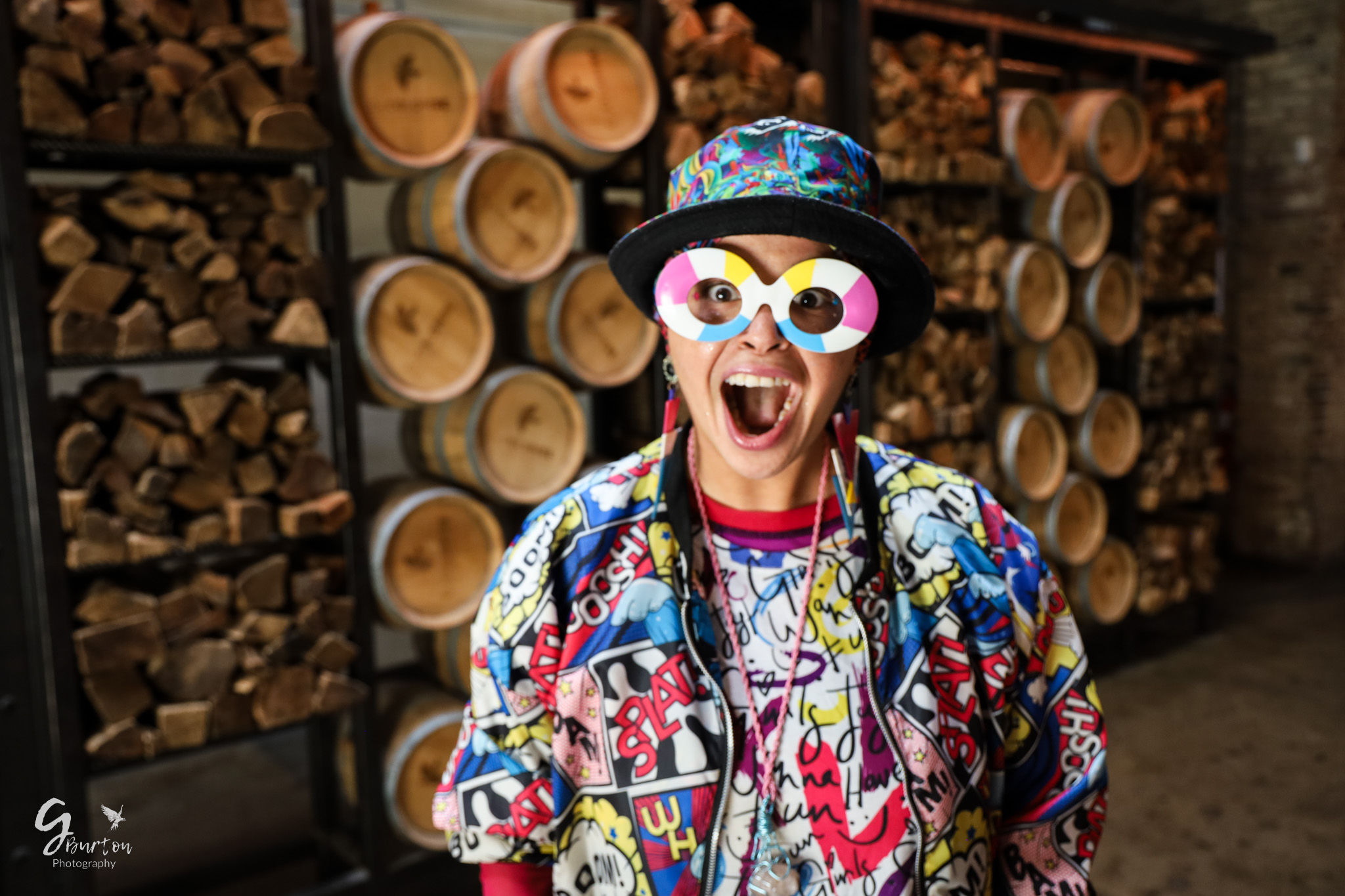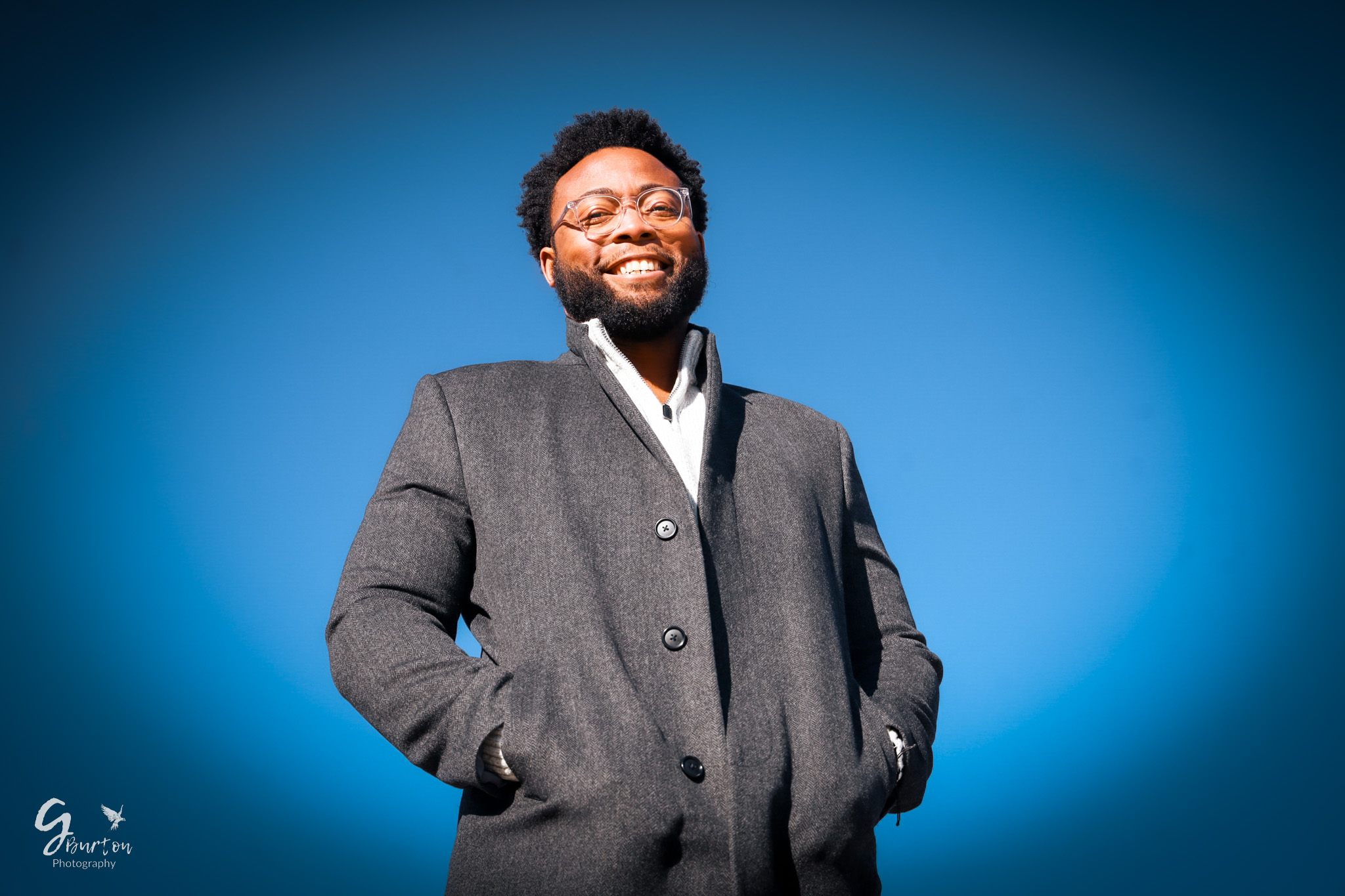Some people follow a straight line. Thalia Elie prefers a swirl, a spin, a spontaneous cha-cha of reinvention.
She’s an Afro-Latina artist, author, hairstylist, photographer, tech visionary, and ordained minister (Bible in one hand, Black Girl Magic in the other.)
She has stitched showstopping gowns for Macy’s runways, had her photography light up Times Square and grace the walls of the Louvre (Yes, the Paris Louvre. Not the one next to the laundromat), worked magic on natural curls in one of Philly’s hottest salons, and engineered tech cloud solutions like she was braiding code into art.
Call it a résumé, but it’s really a vibe.
And now? She’s channeling that same brilliance into the pages of a children’s book.
Threaded through it all, quietly and powerfully, is love … and faith.
“Love is my life’s purpose,” Thalia says, without hesitation. It’s a philosophy she’ll tell you she’s lived by since the age of eight.

“When I was a kid, my father would get stressed about bills. I didn’t know how to solve grown-up problems, but I knew that when I hugged him, it made him feel better. That was the first time I realized what love could do.”
Around that same time, a spiritual awareness also started to take shape. She recalls sitting on her father’s lap as he gently opened the Bible and spoke to her about Jesus.
“I don’t remember the exact words he said, but I cried. It felt big. And important,” Thalia explains.
From that moment on, faith took root, love became her rhythm, and storytelling was how Thalia started to move through the world.
Adventures in Hair and Heritage
Carrying a vibrant mix of African, Haitian, and Costa Rican heritage, Thalia was raised in a home where storytelling came standard, right between dinner and dancing in the living room.
“When I was young, we would watch the Discovery Channel, mute the volume, and my brothers would make up hilarious voiceovers for the animals,” she chuckles. “Those silly, creative moments with my brothers … that’s where my love for storytelling really began.”
And while most kids outgrow make-believe, Thalia just leveled up. Her imagination never stopped running and neither did she.
Every stop on her journey, whether expected or delightfully off-script, added a new layer to her voice. And eventually, that voice blossomed into a crescendo of love in full technicolor curls.
Enter Hair We Go!: The Storyteller’s Stone, Thalia’s debut children’s book.

Make no mistake, the book is a love letter to Black hair, global heritage, and cultural pride. A reclamation. A joyful rebellion.
In this first installment of her Curly Girls’ Adventure Series, Thalia reimagines Africa as a continent bursting with wonder and reminds every kid with curls that they’re part of something ancient, proud, and powerful.
Her purpose? Transform how young readers, especially those of African descent, view themselves and their hair.
“Representation matters,” Thalia says, her voice vibrant with conviction. “Kids deserve to see themselves not just as background characters, but as the heroes of their own stories. And they deserve to see an Africa that’s not filtered through outdated textbooks or charity ads. An Africa that is radiant and real. “
Each book in the series shines a spotlight on a different African country, blending real-world traditions, vibrant foods, native languages, and local legends with a dash of cultural stardust.
The Storyteller’s Stone whisks readers away to Cape Town, where Yaya, a spirited young girl with a crown of twisted curls, discovers a magic traveling stone that enables her to teleport anywhere on Earth and unravel the secrets of ancient ancestral wisdom.

Yaya races to save her African tribe from extinction by finding a mysterious storyteller in Africa whose tale holds the key to their survival.
Shadowing her every step is a ruthless exile, determined to steal the tribe’s magic and claim its power as his own.
But Yaya’s tribe has a secret weapon … their hair. Magical, mystical, and deeply rooted in identity, it becomes a tool for survival, transformation, and power.
“Yaya is the heartbeat of a new narrative … one where Black children see Africa as a place of possibility, beauty, and brilliance,” Thalia says.
The Curl That Changed Everything
Ask Thalia where the spark for Hair We Go! came from, and she’ll take you back to one pivotal moment when she was a hair stylist.
She was working at Duafe, Philadelphia’s trendsetting holistic Black hair care salon, when a quiet storm walked through the door.
A young multi-ethnic boy entered with his white, French mother. His curls were painfully tangled, his spirit even more so. His thick, coiled hair had become a silent battlefield between parents who loved him but didn’t yet understand how to love his hair.
“His mom was completely overwhelmed,” Thalia recalls. “She had no clue how to care for his curls. His dad, who was Black, felt like it was her responsibility because she was the mother.”
The friction between the parents filled the room, and it was the child who carried the weight of their misunderstanding.
“What the parents didn’t realize,” Thalia says, “was that their frustration extended beyond detangling curls, it was really about cultural identity. The message their son was receiving wasn’t … your hair is difficult. It was … you are difficult. That moment stayed with me.”
For Thalia, that day was God planting purpose and when the idea for writing Hair We Go! came to life.
“I wanted to create something that celebrated curls, that showed kids their hair is sacred. And to make it easier for parents, I even added hair care tutorials in the back of the book, turning hair time into something joyful instead of frustrating.”
Thalia’s years behind the salon chair gave her a front-row seat to how hair often shapes self-worth.
“Hair is never just hair,” she says with a knowing smirk. “It’s identity, history, and attitude … all twisted up in one crown. I want every kid who’s been told their curls are ‘too much’ to know the truth … your hair is magic. Period.”
Turns out, that magic wasn’t limited to storybooks.
Thalia’s whole life has been one long remix of creativity and purpose, blending culture, confidence, and style into whatever medium called her next.
Draped in Meaning: Stitching Stories Through Fashion
Before she was writing children’s books, Thalia was sketching stories with plastic stencils and flair pens.
Her gateway drug? Fashion Plates: My Style, those iconic mix-and-match templates that let her dream up runway looks long before she knew what a runway was.

But it was a high school sewing class that changed everything.
“That’s when I realized making clothes wasn’t only about function. It was art. And way more interesting than periodic tables,” she laughs. “Daddy was a chemist and wanted all of us to be scientists [insert eyeroll].”
That fashion spark led her to the Philadelphia College of Textiles and Science (now Thomas Jefferson University), where she landed a full scholarship to study Design and Business Management.
For a young woman bursting with creative energy, it felt like the start of something wonderful.
“I was creating stories even during college,” she explains. “Fabric, color, movement … they could all tell a narrative.”
But college life would bring bigger challenges than textbooks and thread counts.
“As a Haitian daughter, I wasn’t allowed out much growing up,” Thalia explains.
“So, when I got to college and had all that freedom, I got a little distracted. Let’s just say my GPA was not touched by the anointing that year.”
Thalia’s first year of college came with a plot twist – she lost her scholarship and landed back home, staring down a hard reset.
Loans, applications, faith. She re-applied, re-enrolled, and quietly began rebuilding, academically and spiritually.
Faith in Motion: Rooted in Spirit
But as she rebuilt her academic path, something more lasting began to take shape. Back on campus, Thalia wandered into New Hope Baptist Church, and stayed.
It was there she met Pastor Clarence Pemberton, an elder with a gentle voice and a gospel heart. “God took Mommy when I was seven,” she says. “But He gave me two dads. Pastor raised me in the Word.”
“When I started spending time with pastor and young ministers, they felt like kindred spirits. I noticed that they genuinely led with love and compassion, and I realized that everything I’d already devoted myself to … kindness, patience, radical love … it was all right there in the teachings of Jesus.”
Faith, for Thalia, was a personal relationship. “People will try and tell you all the things you have to do to earn love. Turns out, you don’t. You’re already loved. You just have to receive it. I think of Jesus as the whisper that reminds me … I’m already loved.”
Eventually, her spiritual walk led to ordination, not as a career move, but as a sacred affirmation.
“Becoming an ordained minister was about choosing love. Every day. No matter what,” Thalia says. “Pastor used to tell us, ‘Every person is called to serve humanity.’ Saying yes to that call was just me recognizing who I already was.”
That clarity became her oxygen. It gave her room to breathe and room to build.
“God is in everything I do,” she says. “Every spark of inspiration, every pivot, every door that opens … I see God in that. My creative self is my God-created self.”
Runway Revelation: The Macy’s Red Dress
And the next door that opened? Well, it involved the Big Apple and a runway.
Fresh out of college, Thalia was in hustle mode, hairstyling by day, retail by night, and dreaming in red-carpet visions in between.
“I was grinding,” she says. “Three jobs at once just to fund my art. I was tired, but my spirit wasn’t. The vision kept tapping me on the shoulder like, ‘Sis… we’re not done.’”
That relentless drive was about survival and purpose. Thalia really wanted her work to mean something.
So when she came across the Macy’s Red Dress Collection competition, a high-profile showcase for up-and-coming designers raising awareness for women’s heart health, she knew it was bigger than a contest.
“I wanted my design to be more than a dress,” Thalia recalls. “I wanted it to pulse with life.”
Her submission, a molten red gown that shimmered like liquid fire, was inspired by the power and resilience of womanhood.
“I thought about blood as life force, an energy that fuels movement, power, and passion,” she explains. “I designed the dress to feel alive, like it was carrying the very essence of the woman wearing it.”
The competition was fierce, with designers from across the country vying for a coveted spot. To Thalia’s surprise, and delight, she was selected to showcase her design in New York City’s famous Fashion Week.
“When that email came from Macy’s stating that my gown had been selected … honey I just stared at the screen in disbelief. I was like… wait, they picked me?” she laughs.
The showcase was a whirlwind. Her gown flowed down the runway beside designs from some of the brightest emerging talents in fashion. But for Thalia, the moment transcended the visual.
“Clothing isn’t just about how it looks,” she says. “It’s about how it makes you feel. Watching my piece move down that runway, I felt the energy shift. That’s when I knew I was channeling something bigger.”
The recognition from Macy’s opened doors. She found herself backstage at New York Fashion Week, styling models, curating collections, and collaborating with designers who spoke the same fluent dialect of fabric and form.
But even in the glamour of the fashion world, she wasn’t making enough money to make ends meet, and she couldn’t shake a lingering question … How deep can this impact really go?
“I loved the creativity,” she says. “But I wanted to create something that outlasted the moment. I wanted permanence. Legacy. Something you could hold onto.”
Like so many times before, a questioning moment didn’t close a door—it cracked open another.
Her next reinvention? Photography.
Through the Lens: A New Frame of Expression
Fashion had taught Thalia how to tell stories in movement. Photography taught her how to capture them in stillness.
What started as a creative curiosity quickly became a powerful medium of impact, and to Thalia’s surprise, a way to pay the bills.
“At first, it was another creative outlet,” she says. “But then I started realizing… photography pays. People need portraits, brands need campaigns, galleries pay for exhibits. And they write checks.”
Through her camera, Thalia documented beauty, composing symphonies of identity, pride, and presence.
One of her most striking images, two girls in a shipping crate with the branded phrase #bringbackourgirls burnt into the crates, lit up a 25-story screen in the middle of Times Square in New York City.
It was a tribute to the Chibok girls in Nigeria that Boko Haram kidnapped for attending school.

“It was surreal,” Thalia says. “You don’t expect to see your art towering over tourists in such a monumental public space. I was thrilled because that photo was meant to make people stop, look up, and feel something.”
But Times Square was just the warm-up.
Another photo, a hauntingly beautiful image of a Black man perched powerfully in a tree, earned a spot in a collective exhibition at the world famous Louvre museum in Paris, France.



Thalia’s reaction to having her photo shown at the Louvre was a mix of awe, humility, and quiet disbelief.
“It was wild,” Thalia says. “A Black man in a tree… hanging in the Louvre? That’s legacy work.”
“Trees carry so much history,” Thalia explains. “For Black people, they’ve represented trauma. I wanted to reimagine that … turn the tree into a symbol of rest, reclamation, and elevation.”
The only thing missing was Thalia herself.
“I wasn’t able to attend the Louvre exhibition because I had my first solo exhibition called Selfie Esteem here in PA at the same time,” she shrugs. “But I didn’t need to be there to know what it meant.”
“That moment … my work hanging in the Louvre … felt like a whisper from my ancestors saying, ‘We see you. Keep going.’”
Hustle Meets Technology: Making Magic and Making Rent
But even with portraits lighting up Times Square and museum walls in Paris, the art world had its ceilings, and Thalia was ready to break through them.
Galleries had gatekeepers. Grants came and went. She craved autonomy, reach, and resources, the kind that let you dream without asking permission.
So, in true Thalia fashion, she pivoted. This time? Into tech.
“Listen, I love art,” she grins. “But I also love eating. I couldn’t keep relying on vibes and freelance checks.”
Fashion had opened glamorous doors, but it wasn’t exactly paying the rent on time. Photography brought in real income, but it was still feast or famine. Thalia wanted something scalable. Something steady.
The unexpected spark for technology was revealed through a creative project.
“I was working on my Selfie-Esteem exhibit and needed an app,” Thalia recalls. “So, I went to Philly Tech Week. And there were all these people laying in hammocks, building software, and brainstorming how to change world. And getting paid?! I thought, ‘Oh, I could definitely do this.’”


And just like that, Thalia fell down the tech rabbit hole.
With her usual brand of curiosity and grit, she threw herself into the world of cloud computing and earned an AWS Solutions Architect certification, one held by only a small percentage of professionals worldwide.
“Tech gave me breathing room,” she says. “I could finally focus on my art without worrying about how to pay my bills.”
That financial stability ultimately gave Thalia the space to write her book.
“Writing a book isn’t something that pays you upfront,” Thalia opines. “You have to really believe in it and give it time to grow.”
And for Thalia, money was never the why, but it was always part of the how. She learned early on that true creative freedom comes from not being financially dependent on anyone else’s permission.
And that’s why every pivot she made was about building a life where she could create on her own terms.
The Art of Becoming
Reflecting on her journey, Thalia recognizes that her path, though winding, has never been aimless. Every step has been infused with a profound desire to uplift, empower, and affirm others.
Whether she’s designing a dress, decoding a cloud, or crafting a children’s book, she communes with the divine. With purpose. With possibility.
She’s proof that you can move through the world with both fire and faith. That resilience can be your runway. That creativity and calling can dance in the same sentence. And that the universe offers us many open doors.
And that’s the magic of Thalia Elie. She’s building a testimony. One chapter at a time.





Leave a Reply